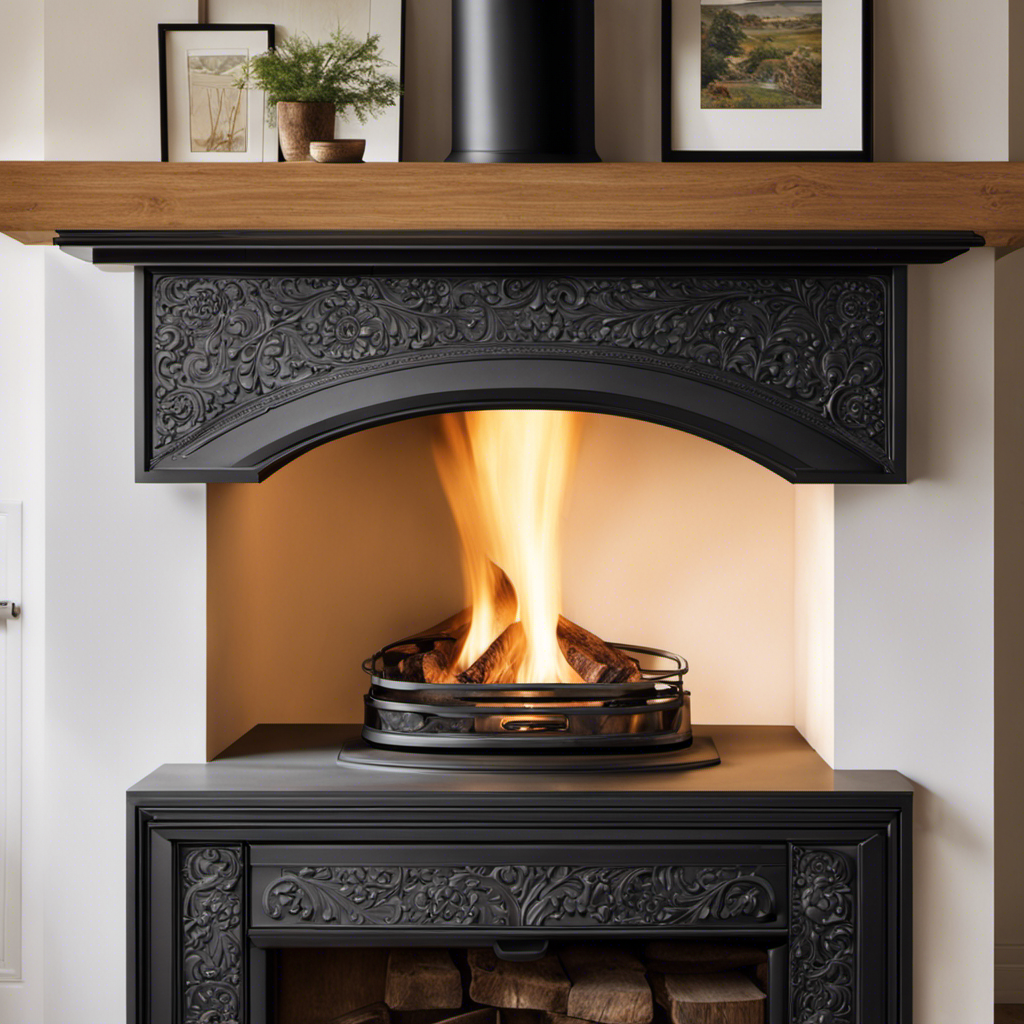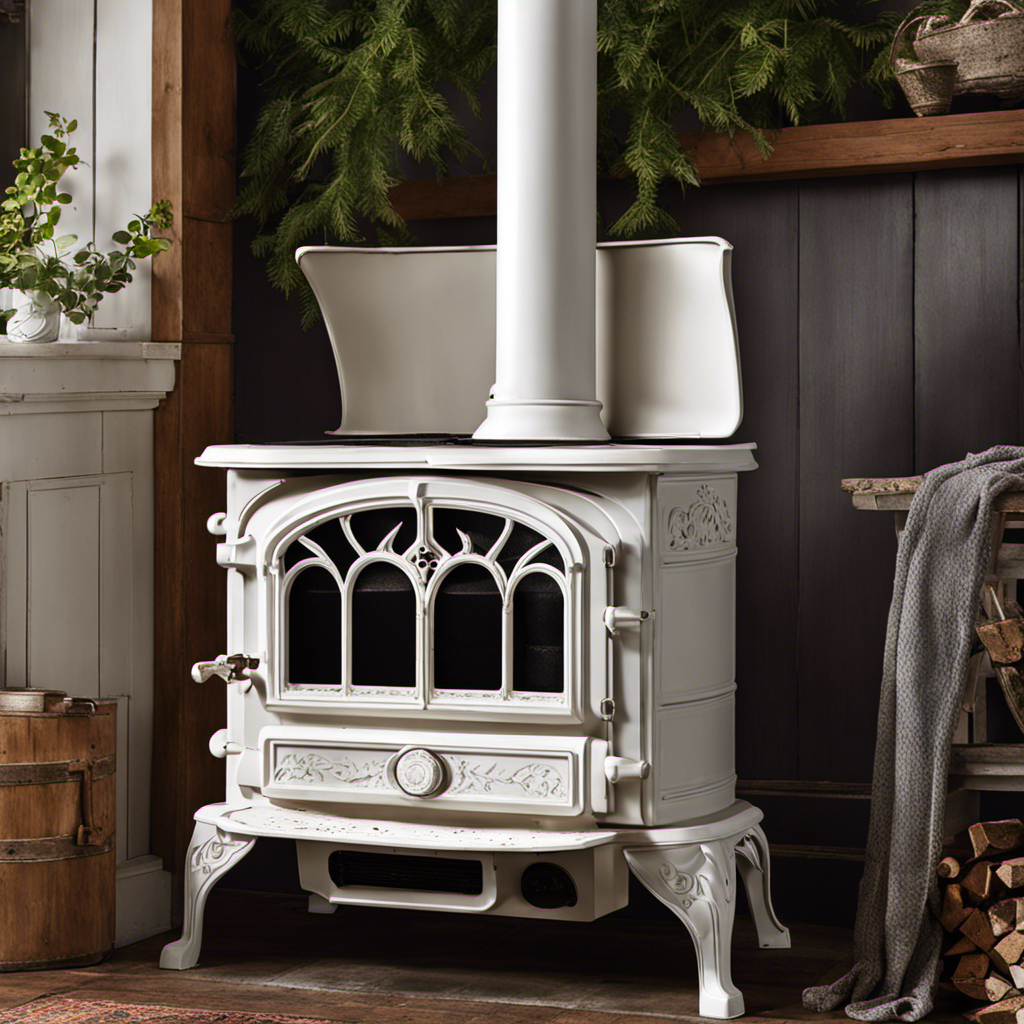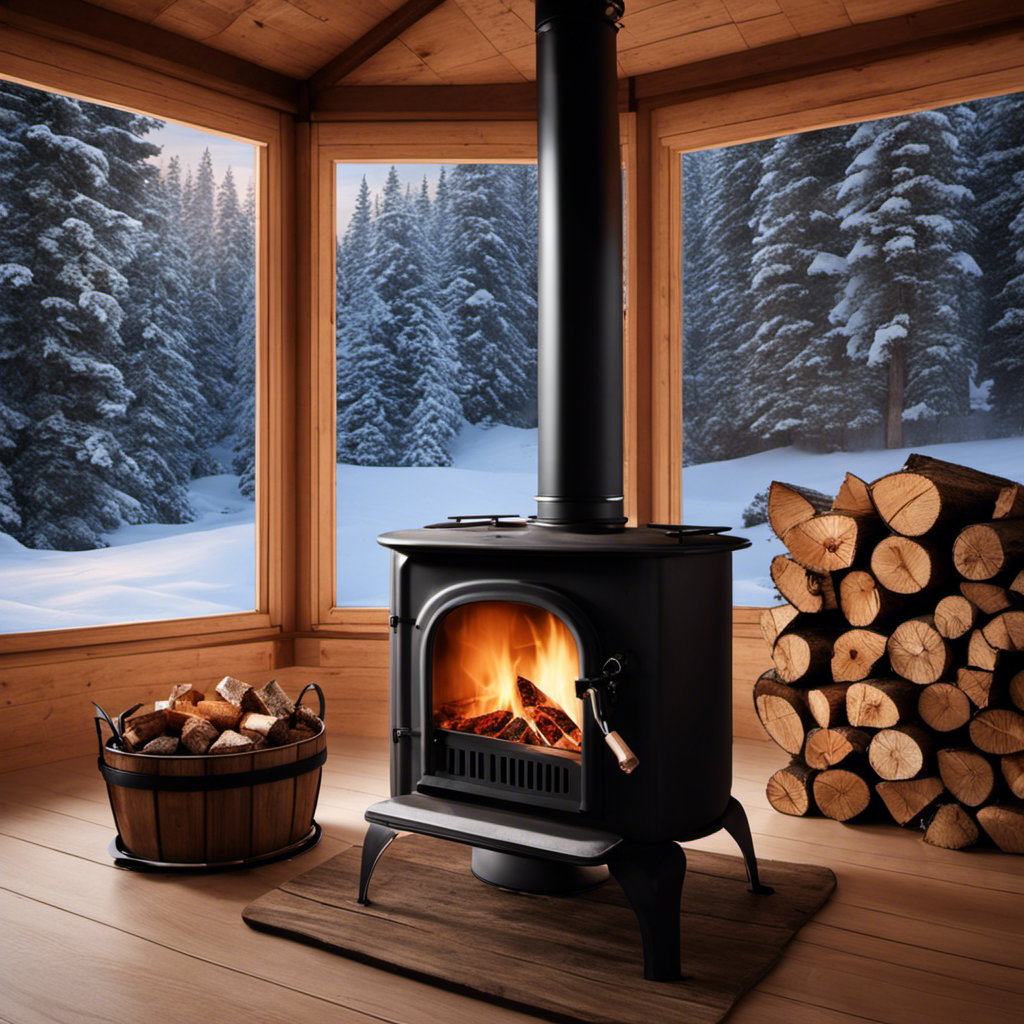I have found a reliable way to remove rust from my Fisher wood stove.
Rust can be a stubborn problem, but with the right techniques and materials, you can restore your stove to its former glory.
In this article, I’ll guide you through the step-by-step process of rust removal, from understanding the causes to applying effective techniques.
Say goodbye to rust and hello to a well-maintained, rust-free Fisher wood stove that will last for years to come.
Key Takeaways
- Exposure to moisture can cause rust formation on a Fisher wood stove.
- Burning wet or unseasoned wood releases moisture, promoting rusting.
- Keeping the stove dry and well-ventilated helps prevent rust formation.
- Regular cleaning, inspection, and applying a protective coating can prevent rust on a Fisher wood stove.
Understanding the Causes of Rust on Your Fisher Wood Stove
I often wonder why my Fisher wood stove rusts so easily.
Rust formation on a wood stove can be caused by several factors. One of the main causes is exposure to moisture. When moisture comes into contact with the metal surface of the stove, it can create a chemical reaction that leads to the formation of rust.
Another factor that contributes to rust formation is the burning of wet or unseasoned wood. As the wood burns, it releases moisture into the air, which can condense on the stove and promote rusting.
To prevent rust formation, it’s important to keep the stove dry and well-ventilated. Regularly cleaning and inspecting the stove for any signs of rust or damage is also crucial. Applying a protective coating or paint specifically designed for wood stoves can provide an additional layer of protection against rust.
Gathering the Necessary Tools and Materials for Rust Removal
To remove rust from my Fisher wood stove, I’ll need a wire brush and some rust remover. The rust removal process involves the following steps:
- Begin by thoroughly cleaning the surface of the stove to remove any dirt or debris.
- Use the wire brush to gently scrub away the loose rust particles.
- Apply the rust remover according to the manufacturer’s instructions, ensuring full coverage of the affected areas.
- Allow the rust remover to penetrate and dissolve the rust, typically for a recommended amount of time.
Once the rust has been successfully removed, it’s important to take preventive measures to avoid future rust formation. This can be done by:
- Applying a high-quality stove paint or protective coating to create a barrier against moisture and oxidation.
- Regularly inspecting and maintaining the stove to identify and address any potential rust-prone areas.
- Keeping the stove dry and ensuring proper ventilation to minimize moisture buildup.
- Using a rust inhibitor or anti-corrosion spray on vulnerable parts.
By following these steps, you can effectively remove rust from your Fisher wood stove and take proactive measures to prevent its recurrence.
Now, let’s move on to preparing your Fisher wood stove for rust removal.
Preparing Your Fisher Wood Stove for Rust Removal
After thoroughly cleaning the surface of my Fisher wood stove and gathering the necessary tools, I am ready to begin removing the rust. Preparing your wood stove properly is crucial for effective rust removal and rust prevention. Here are some preparing techniques to follow:
| Preparing Techniques | Rust Prevention |
|---|---|
| Sanding | Apply a rust inhibitor after removing the rust to prevent future rust formation. |
| Scraping | Keep the stove dry to avoid moisture buildup, which can lead to rust. |
| Priming | Regularly inspect and clean the stove, removing any debris or ashes that may cause rust. |
By sanding the rusty areas, you remove the top layer of rust and create a smooth surface for treatment. Scraping helps remove loose rust particles and prepares the surface for further treatment. Priming the surface with a high-quality primer creates a protective barrier, preventing rust from forming in the future.
Applying Effective Rust Removal Techniques to Your Wood Stove
Using a wire brush, I carefully scrub the rusty areas of my wood stove, effectively removing the rust and restoring its appearance. Rust formation is a common problem with wood stoves, but with the right techniques and products, it can be prevented and treated efficiently.
Here are some key points to consider:
-
Regular cleaning: Regularly cleaning and maintaining your wood stove can help prevent rust formation. Make sure to remove any ashes, soot, or debris that can trap moisture and contribute to rusting.
-
Choosing the right rust removal product: There are various rust removal products available in the market, such as rust converters, rust removers, and rust inhibitors. Depending on the severity of the rust, choose the appropriate product that suits your specific needs.
-
Proper surface preparation: Before applying any rust removal product, it’s crucial to prepare the surface properly. This includes removing loose rust and dirt, sanding the surface if necessary, and ensuring it’s clean and dry before applying the rust removal product.
-
Applying a protective coating: After removing the rust, it’s advisable to apply a protective coating to prevent future rust formation. This can be achieved by using high-temperature paint or a specialized stove polish.
Maintaining a Rust-Free Fisher Wood Stove for the Long-Term
As an owner of a Fisher Wood Stove, I regularly inspect and clean the surface to prevent rust and ensure its long-term durability.
To provide long-lasting protection and prevent future rust, there are a few key steps that I follow.
Firstly, I start by thoroughly cleaning the surface of the stove using a mild detergent and warm water. This helps to remove any dirt or debris that may be present.
Once the surface is clean, I use a wire brush to gently scrub away any rust that has formed. It’s important to be cautious and avoid scratching the surface while doing this.
After removing the rust, I apply a high-quality stove paint or heat-resistant paint that’s specifically designed to withstand the high temperatures of the stove. This paint not only adds a layer of protection but also enhances the overall appearance of the stove.
Lastly, I regularly inspect the stove for any signs of rust or damage and address them promptly.
Frequently Asked Questions
How Long Does It Take to Remove Rust From a Fisher Wood Stove?
It typically takes a few hours to remove rust from a Fisher wood stove, depending on the extent of the rust. To prevent rust, regularly clean and maintain the stove, and consider using rust removal products recommended for Fisher wood stoves.
Can I Use Household Cleaning Products to Remove Rust From My Wood Stove?
Sure, you can use household cleaning products to remove rust from your wood stove, but vinegar is a cheaper and more effective option. There are also other methods like sanding or using rust converters.
Is It Necessary to Remove All the Rust From the Wood Stove or Just the Visible Areas?
When removing rust from a wood stove, it’s important to prioritize all areas, not just the visible ones. After rust removal, it is safe to use the wood stove immediately without waiting.
Can I Use Sandpaper to Remove Rust From My Fisher Wood Stove?
Sure, sandpaper can be used to remove rust from a Fisher wood stove. It’s a practical and cost-effective method, but it may require some elbow grease. Other alternatives like chemical rust removers or wire brushes are also worth considering.
Is It Safe to Use the Wood Stove Immediately After Removing Rust or Should I Wait for a Specific Period of Time?
It is safe to use the wood stove immediately after removing rust. However, it is recommended to wait for a specific period of time to ensure all cleaning products have evaporated. To prevent rust, regularly clean and maintain the stove.
Conclusion
In conclusion, by understanding the causes of rust on your Fisher wood stove and following the proper rust removal techniques, you can ensure a long-term, rust-free stove.
Remember the adage ‘an ounce of prevention is worth a pound of cure’ and regularly maintain your stove to prevent rust from forming.
With the right tools and materials, you can keep your Fisher wood stove in top condition for many years to come.
Growing up surrounded by the vast beauty of nature, Sierra was always drawn to the call of the wild. While others sought the comfort of the familiar, she ventured out, embracing the unpredictable and finding stories in the heartbeat of nature.
At the epicenter of every remarkable venture lies a dynamic team—a fusion of diverse talents, visions, and passions. The essence of Best Small Wood Stoves is crafted and refined by such a trio: Sierra, Logan, and Terra. Their collective expertise has transformed the platform into a leading authority on small wood stoves, radiating warmth and knowledge in equal measure.











